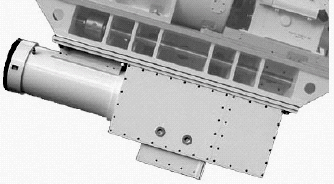|
Video Tracking Camera |
||||
|
|
The Video Tracking Camera is designed for very high performance daylight video imaging. The camera delivers monochrome CCIR or RS170 format video with over 1,000 pixels per line and 4:3 aspect ratio. | |||
| Video Tracking Camera | ||||
|
Resolution:
1000 pixels per line Aspect Ratio: 4:3 Contrast transfer: > 100% @ 6.4 MHz Sensitivity: > 6 lux @ minimum gain < 0.5 lux @ maximum gain Signal-to-Nose Ratio: >52db @ minimum gain Gain: > 24 dB, automatic or manual Gamma: 1 or 0.45 Integration period: Manual 20, 10, 5, 1 msec Mirror readout: Option left to right |
||||
| Tracking Lens | ||||
| The 400-3000mm Zoom Lens is a 180mm aperture (7 inch) catadioptric lens that yields a zoom ratio of 7.5 to 1. The short focal length of the lens is operating at f/2.2 while at the long focal length the ratio has increased to f/16.9 The primary optical design is a Maksutov Cassegrain type and consists of both refractive and reflective elements that have been ruggedized to withstand a maximum of 10Gs shock load. A common mounting plate is provided to support the optical system and the camera as well as a camera platform to establish proper alignment between camera and the optical axis. | ||||
| General Specifications | ||||
|
Lens Design:
Maksutov Cassegrain Clear Aperture: 180mm (7 inches) Focal Length: Zoom – 400mm (15.76 inches) to 3045mm (120 inches) Geometrical f ratio: f/2.2 through f/16.9 Resolution: .65 arc second (diffraction limited) Material: Primary Mirror – Zero-Dur Substrate Corrector Lens: BK-7, Focusing Lens Coatings: All reflective surfaces – Enhanced Aluminum All air-glass surfaces – AR – with MgF2 |
||||
|
The 400-3000mm Zoom Lens
is made up of several subassemblies: lens barrel, lens/mirror, beam
splitter, neutral density filter wheels, and video camera. The zoom
lens consists of both refractive and reflective elements that are
located in the lens barrel. The advantage of a catadioptric (mixed
lens and mirror) design is that the triple light path through the
lens barrel allows relatively "powerful" optics to be packaged into
a compact barrel. Both the corrector lens and primary mirror are
hard mounted and do not move. The optical front end is constructed with Invar, and in combination with the DOS temperature-compensated barrel design, bore sight is maintained to within ±5 arc seconds, over a 50ºF temperature variation and focus is also maintained. A pellicle beam splitter is positioned at a 45º angle to the main optical axis to allow the super-positioning of a reference reticule pattern at the intermediate image plane. The 95%-5% split has little effect on the main beam, but does allow a brightly illuminated reticule to serve as a calibration and camera replacement aid if desired. The system includes a matched set of counter-rotating neutral density filter wheels, which when activated, provide a continuously variable density with even attenuation across the video format. This is accomplished without altering the geometrical f ratio, thus being preferable over the conventional mechanical iris. The neutral density wheels can be operated manually via switch closures, or serve as an auto-iris with any TV camera that provides p-p video level. Serial communications port neutral density level control is available with auto/manual override mode select. The video camera is
also housed in the rear enclosure, and the camera/lens assembly is
sealed against dust and moisture. It is pressurized with dry
nitrogen with a leak rate not exceeding two pounds per square inch
in 168 hours. It comes complete with Shraeder valve for
re-pressurizing, safety relief valve, and pressure gage to determine
proper pressure. Rechargeable desiccant cartridges are installed,
which guard against internal moisture forming. It is a safeguard in
the event internal pressure has not been maintained at the proper
level. Remotely controlled focus, with actuation by a
microprocessor-controlled servomotor, provides a focusing range of
1000 feet to infinity. The servo axis is under redundant software
and hardware limit switch control to prevent |
||||
|
Photo-Sonics, Inc. 818-842-2141 (ph - switchboard paging) 818-842-2610 (fax) mail@photosonics.com |
||||
| <back to top> | ||||
|
© 2019 Photo-Sonics, Inc. |
||||

